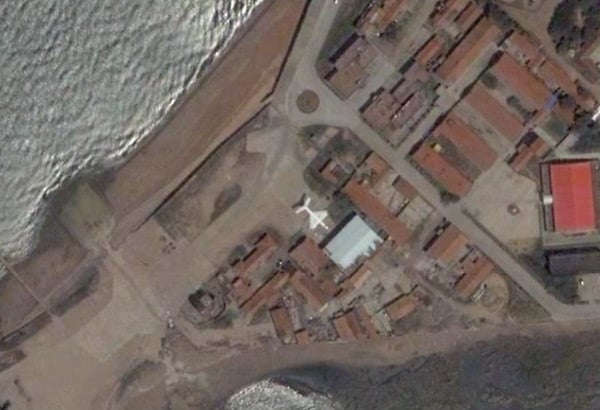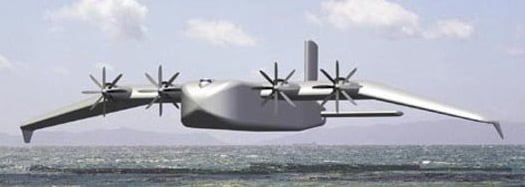This article is more than 1 year old
In search of the Caspian Sea Monster
Strange sightings on Google Earth
Caveat: some historical details and aircraft specifications in this piece are based on a variety of sources - not all of which agree. We've done our best to provide what we believe are the right facts and figures, but some aspects of the ekranoplan story are still open to debate.
During the mid-1960s chilly height of the Cold War, US photo reconnaisance spotted a strange apparition on the shores of the Caspian Sea - a gigantic 100m-long aircraft with inexplicably truncated square wings. US Intelligence dubbed the beast the "Caspian Sea Monster", unaware that the Russians were developing not, as they thought, an enormous conventional seaplane, but rather a 550-ton water-hugging behemoth designed to use the ground effect to skim the ocean at high speed, undetected by radar.
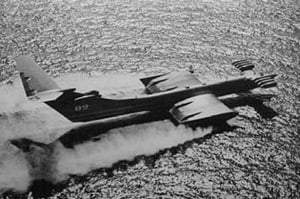 The Russians had a rather more prosaic name for the Caspian Sea Monster: the KM or "korabl-maket". This "ship-prototype" was the first in a series of Soviet "ekranoplan" ("screen plane") developments and was designed by Rostislav Evgenievich Alexeev of the Central Hydrofoil Design Bureau. The KM was intended as a test platform to examine the possibilities of the "Wing In Ground" (WIG) effect whereby (in very simple terms) a wing travelling close to the ground is provided with extra lift by the "cushion" of air compressed under it - thereby enabling a combination of greater aircraft weight for less power and/or enhanced fuel economy.
The Russians had a rather more prosaic name for the Caspian Sea Monster: the KM or "korabl-maket". This "ship-prototype" was the first in a series of Soviet "ekranoplan" ("screen plane") developments and was designed by Rostislav Evgenievich Alexeev of the Central Hydrofoil Design Bureau. The KM was intended as a test platform to examine the possibilities of the "Wing In Ground" (WIG) effect whereby (in very simple terms) a wing travelling close to the ground is provided with extra lift by the "cushion" of air compressed under it - thereby enabling a combination of greater aircraft weight for less power and/or enhanced fuel economy.
The KM, powered by eight Dobryin VD-7 turbojets on the front of the fuselage, and two on the tail for extra thrust during take-off, first took to the air in October 1966. During its extensive test career, it was continually modified. The wingspan was altered to between 32m and 40m, and the length varied from 92m to 106m.
The KM crashed in 1980, apparently due to the pilot ill-advisedly attempting to take off without giving it full throttle. An attempt to recover the leviathan from the depths was thwarted by its vast weight.
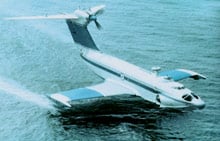 While the KM programme was ongoing, Alexeev began work on a medium-sized ekranoplan suitable for military transportation duties. Dubbed A-90 "Orlyonok" ("Eaglet"), the 140 tonne, 58 metre long aircraft had its maiden flight in 1972. The A-90 boasted two turbojets and one turboprop engine which propelled it to a speed of 400 km/h for 1,500 km at an cruise altitude of 5-10 m.
While the KM programme was ongoing, Alexeev began work on a medium-sized ekranoplan suitable for military transportation duties. Dubbed A-90 "Orlyonok" ("Eaglet"), the 140 tonne, 58 metre long aircraft had its maiden flight in 1972. The A-90 boasted two turbojets and one turboprop engine which propelled it to a speed of 400 km/h for 1,500 km at an cruise altitude of 5-10 m.
Four flying examples were built, one of which crashed in the Caspian in 1975 and was subsequently rebuilt. The aircraft entered military service in 1979 with three A-90s reportedly still operational in 1993. Thereafter, they were reportedly mothballed at the Kaspiysk naval base on the Caspian.
As indeed they were, or at least one of them. A quick Google Earth jaunt down to Kaspiysk reveals this fine view of an Orlyonok parked up:
There's more: sitting close by is this rather magnificent beast:
It is, as ekranoplan aficionados among you will know, the original military version of the "Lun" ("Hen Harrier"), designed as a sea-launched anti-shipping missile platform.
The 280 tonne, 74 metre long M-160 Lun was another ekranoplan developed from Alexeev designs. One was built in 1987, which entered service in 1989. A second example was under construction when the Soviet Union collapsed and, despite subsequent refitting as a search-and-rescue aircraft, remained unfinished when the authorities effectively pulled the plug on ekranoplan funding.
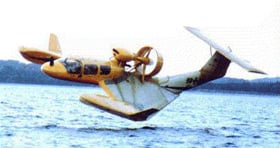 Russia wasn't the only country to take an active interest in the possibilities of WIG aircraft, though.
Russia wasn't the only country to take an active interest in the possibilities of WIG aircraft, though.
In the early 1960s, German designer Alexander Lippisch threw his hat into the ring with a series of small-scale designs based on a reverse delta-wing configuration.
Lippisch was an expert in delta-wing aerondynamics, having played a large part in the design of the famous Me-163. His X-112 and X-113 designs were developed by Rhein Flugzeugbau (RFB) into the X-114 (seen here) for the German military.
Neither the X-114 nor any of its derivatives ever made it into military service, but there is some evidence that China may have taken a close interest in the design.
Specifically, readers are invited to speculate as to exactly what the Chinese are up to down at Qingdao naval base:
Well, the circumstantial evidence is there: a launch ramp down to the water's edge; hangar-type building; and the proximity of a seaplane base (click here. For the record, those are Shuihong-5 amphibious aircraft sunning themselves on the shore).
On the other hand, our Chinese Sea Monster is only 20 metres long, although a close-up examination adds weight to the theory that it may be the China Ship Scientific Research Centre's XTW-4 - based on the Lippisch X-113 (seen right) or X-114, as proposed by members of the Google Earth community:

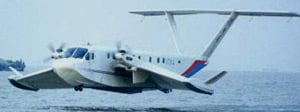 Shown here is a clearer view of the XTW-4. It's powered by two turboprop engines driving two five-blade propellors, and has a corrosion-resistant hull designed for salt-water operations.
Shown here is a clearer view of the XTW-4. It's powered by two turboprop engines driving two five-blade propellors, and has a corrosion-resistant hull designed for salt-water operations.
It was built in 1999 and tested during 2000. Further information is scarce, and its current status is unknown, other than that it appears to be hanging around the Qingdao area. We'll leave it to you lot to fill in the blanks.
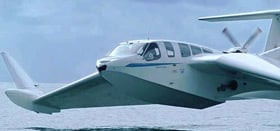 So, what of the future of the ekranoplan? In reality, the technical difficulties of developing a successful example often in the past outweighed the potential benefits of the technology.
So, what of the future of the ekranoplan? In reality, the technical difficulties of developing a successful example often in the past outweighed the potential benefits of the technology.
There have been a few private outfits plugging away at their WIG aircraft, as evidenced by the Flightship FS-8 (seen here). It's another Lippisch-based design which - despite a lot of press back in 2000-2001 amid rumours that the company had sold seven examples to the Maldives - appears to have sunk without trace.
Enter stage right Boeing which, back in 2002, announced that it was developing the mother of all ekranoplans: the monstrous "Pelican" which would stretch "more than the length of a US football field and have a wingspan of 500 feet":
Designed primarily for "long-range, transoceanic transport", Boeing claimed the Pelican would be able to haul "1.5m pounds...10,000 nautical miles over water and 6,500 nautical miles over land".
Naturally, you're going to need a few wheels to hold up an oversized Pelican, and this particular bird - capable of lifting "17 M-1 main battle tanks on a single sortie" - would require no less than 76 tyres on 38 fuselage-mounted landing gears to support its weight.
Impressive specs to be sure, although whether we'll ever be able to do some Pelican-spotting on Google Earth remains to be seen. ®
Related links
- Footage of the Caspian Sea Monster on YouTube. (Thanks to Andrew Hainault for the tip-off.)
Bootnote
There's an intersting theory knocking around that the only reason Howard Hughes' Spruce Goose ever got off the water was due to the ground effect, and that it could never have flown at altitude. It's an idea that has legs, as it were.


